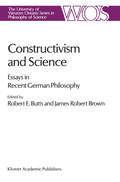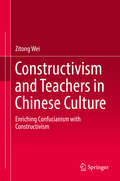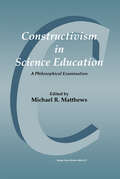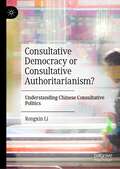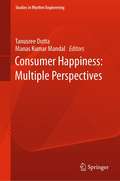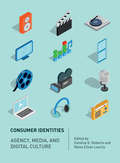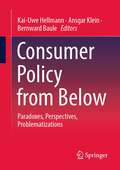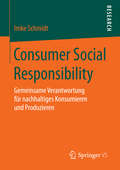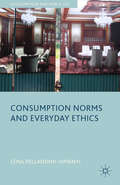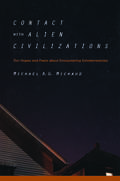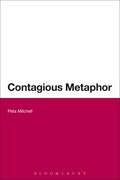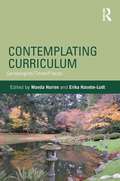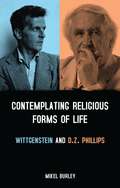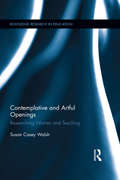- Table View
- List View
Constructivism and Science: Essays in Recent German Philosophy (The Western Ontario Series in Philosophy of Science #44)
by Robert E. Butts J. R. BrownThe idea to produce the current volume was conceived by Jiirgen Mittelstrass and Robert E. Butts in 1978. Idealist philosophers are wrong about one thing: the temporal gap separating idea and reality can be very long indeed - even ten or so years! Problems of timing were joined by personal problems and by the pressure of other professional commitments. Fortunately, James Brown agreed to cooperate in the editing of the volume; the infusion of his usual energy, good judgement and good-natured promptness saved the volume and made its produc tion possible. Despite the delays, the messages of the papers included in the book have not gone stale. An extremely worthwhile exercise in international philosophical cooperation has come to fruition; the German constructivist philosophical position is here represented in papers in English that will make its contemporary importance available to a larger audience. The editors owe thanks to many persons. All involved in the project owe much to the interest and support of Nicholas Rescher, a friend of the undertaking from the time of its inception. My review of the translations was helped immensely by Andrea Purvis' careful copy editing of the typescript. Most of all, however, we owe gratitude and admiration for the tireless efforts on behalf of this enterprise to Jiirgen Mittelstrass.
Constructivism and Teachers in Chinese Culture: Enriching Confucianism with Constructivism
by Zitong WeiThis book provides a refreshing look at kindergarten teachers’ practical knowledge and their context-specific reasoning of the usefulness of constructivism from a culturally emic perspective. Examining the similarities and differences between constructivism and Confucianism from both instructional and moral perspectives, it provides a unique contribution to teaching and teacher education. An understanding of the compatibility between constructivism and Confucianism is valuable in cross-cultural exchange and learning, and as such the book is a great source for educational researchers in a time of globalization.
Constructivism in Science Education: A Philosophical Examination
by Michael R. MatthewsConstructivism is one of the most influential theories in contemporary education and learning theory. It has had great influence in science education. The papers in this collection represent, arguably, the most sustained examination of the theoretical and philosophical foundations of constructivism yet published. Topics covered include: orthodox epistemology and the philosophical traditions of constructivism; the relationship of epistemology to learning theory; the connection between philosophy and pedagogy in constructivist practice; the difference between radical and social constructivism, and an appraisal of their epistemology; the strengths and weaknesses of the Strong Programme in the sociology of science and implications for science education. The book contains an extensive bibliography. Contributors include philosophers of science, philosophers of education, science educators, and cognitive scientists. The book is noteworthy for bringing this diverse range of disciplines together in the examination of a central educational topic.
Constructivity and Computability in Historical and Philosophical Perspective (Logic, Epistemology, and the Unity of Science #34)
by Jacques Dubucs Michel BourdeauRanging from Alan Turing’s seminal 1936 paper to the latest work on Kolmogorov complexity and linear logic, this comprehensive new work clarifies the relationship between computability on the one hand and constructivity on the other. The authors argue that even though constructivists have largely shed Brouwer’s solipsistic attitude to logic, there remain points of disagreement to this day.Focusing on the growing pains computability experienced as it was forced to address the demands of rapidly expanding applications, the content maps the developments following Turing’s ground-breaking linkage of computation and the machine, the resulting birth of complexity theory, the innovations of Kolmogorov complexity and resolving the dissonances between proof theoretical semantics and canonical proof feasibility. Finally, it explores one of the most fundamental questions concerning the interface between constructivity and computability: whether the theory of recursive functions is needed for a rigorous development of constructive mathematics.This volume contributes to the unity of science by overcoming disunities rather than offering an overarching framework. It posits that computability’s adoption of a classical, ontological point of view kept these imperatives separated. In studying the relationship between the two, it is a vital step forward in overcoming the disagreements and misunderstandings which stand in the way of a unifying view of logic.
Consultative Democracy or Consultative Authoritarianism?: Understanding Chinese Consultative Politics
by Rongxin LiThis book theorizes Chinese politics, specifically about China’s “deliberative democracy (xieshang minzhu 协商民主)”. Creating a China-West comparative framework, the author interrogates China's government's claims to give representation to citizens, allowing readers to see how all of these concepts interact within Chinese ideology, democratic discourse, and governance, and their relationship with Chinese authoritarianism. Above all, this book represents a sustained hybridization of political theory, one which is neither a simple democratic-authoritarian dichotomy, nor a reinterpretation of the official propaganda. This study will interest scholars of Chinese politics and statecraft, shedding light on an emergent discourse of the state – Chinese xieshang minzhu. More importantly, this book goes beyond a simple rhetorical and linguistic use of ‘deliberative democracy’ in the Western sense, and rather emphasizes the very consultative nature of Chinese politics, which facilitates and reconsolidates Chinese authoritarianism.
Consumer Happiness: Multiple Perspectives (Studies in Rhythm Engineering)
by Tanusree Dutta Manas Kumar MandalThis book helps quench the quest of knowledge of academicians, researchers, and others interested in developing a complete and critical understanding of consumer happiness. The relentless search of happiness by humans is sought in different ways. Scientific discussion on happiness for long was considered a forte of Philosophers. Other disciplines seldom delved into this. But today not only science but neuroscience, marketing, and other varied fields have started delving into it and have developed a keen interest. The book has been conceptualized on this line of thinking and thus divided into two parts. The first part is customized towards understanding various perspectives of happiness and the relative importance of knowing the same. The first chapter of this section is on the biological perspective of happiness. The second is titled ‘Behavioural perspective’. The third chapter is an attempt to elucidate the cultural perspective of the concept of happiness. The fourth is on the role of technology in inducing happiness. Fifth and sixth are on theories of happiness and measuring happiness, respectively. Knowledge about the different perspective and theories has a wide range of benefits. It informs us about how the brain works, interprets, and reacts. This theoretical understanding helps us to move beyond the trial and error methods towards a more scientific underpinning of adoption of measures that would generate long-lasting happiness in consumers.The second part of the book is dedicated toward understanding consumer happiness from a neuroscience perspective, i.e. keeping consumer happy. This segment has ten chapters. The first is on differentiating the concept of happiness from satisfaction. The second is on sensory marketing and happiness. The third deals with the store design and shelving of products to generate happiness. Fourth and fifth chapters relate to persuading the consumers. While the fourth chapter is on developing persuasive messages and the fifth is on subliminal messaging sixth chapter is on pricing and seventh on advertising. The eighth chapter highlights the role of emotions and the ninth is on the different factors that induce happiness in consumers. The last chapter is about raising some unanswered questions and food for thought for readers. Together the contents of the book make for a complete understanding of the concept of happiness and how it is shaping the world of marketing. Addressing the ‘what’ and ‘how’ of consumer happiness in the same book makes the book comprehensive.
Consumer Identities: Agency, Media, and Digital Culture
by Candice Roberts Myles Ethan LascityThis edited collection explores the notion of agency by tracing the role and activities of consumers from the pre-Internet age into the possible future. Using an overview of the historical creation of consumer identity, Consumer Identities demonstrates that active consumption is not merely a product of the digital age; it has always been a means by which a person can develop identity. Grounded in the acknowledgement that identity is a constructed and contested space, the authors analyse emerging dynamics in contemporary consumerism, ongoing tensions of structure and agency in consumer identities and the ways in which identity construction could be influenced in the future. By exploring consumer identity through examples in popular culture, the authors have created a scholarly work that will appeal to industry professionals as well as academics.
Consumer Policy from Below: Paradoxes, Perspectives, Problematizations
by Kai-Uwe Hellmann Ansgar Klein Bernward BauleSince its existence in the 1950s, consumer policy in Germany has been understood and pursued primarily as a bundle of actions and measures initiated and institutionalised by the state. In many cases, the state has also issued corresponding mandates and set up support models, which has created the impression that we are basically dealing with a 'consumer policy from above' imposed by macro-politics. Not that there have not been repeated attempts in the past decades to give impetus to consumer policy from the middle of civil society - often in the form of small citizens' initiatives. And in recent years in particular, a number of new consumer organisations have emerged which operate much closer to the grass roots. Nevertheless, the impression seems to have taken root among the large, government-related 'players' in the field, who have been in the 'business' for decades, not to mention government-internal consumer policy, that consumer policy concerns a policy field that is essentially ordered by a collaboration of the state on the one hand, and consumer protection organisations representing all consumers equally on the other, while the many small consumer initiatives, not even started by individual committed consumers, regularly fall behind in comparison. This perspective refers largely to the view of and from the centre of politics. This volume is intended to go some way towards countering the institutionally prevailing impression that, in principle, there is only 'consumer policy from above' that is really effective and assertive.The translation was done with the help of artificial intelligence. A subsequent human revision was done primarily in terms of content.
Consumer Social Responsibility: Gemeinsame Verantwortung für nachhaltiges Konsumieren und Produzieren
by Imke SchmidtImke Schmidt analysiert aus theoretischer und praktischer Perspektive, welche Verantwortung Konsumenten für eine nachhaltige Entwicklung zugeschrieben werden kann. Sie entwickelt dafür ein Modell gemeinsamer Verantwortung, das sich auf die Position und den Einfluss der Marktakteure stützt. Die Autorin setzt die Verantwortung sowohl von Konsumenten (Consumer Social Responsibility) als auch von Unternehmen (Corporate Social Responsibility) in Beziehung zueinander, um gegenseitige Abhängigkeiten bei der Wahrnehmung der jeweiligen Verantwortlichkeiten aufzuzeigen und Möglichkeiten der gemeinsamen Verantwortungsübernahme abzuleiten. Hintergrund ist, dass die Consumer Social Responsibility im Gegensatz zur viel diskutierten Corporate Social Responsibility bisher nicht systematisch in wirtschaftsethische Überlegungen integriert ist und nicht über ein vergleichbares konzeptionelles Fundament verfügt.
Consumption Corridors: Living a Good Life within Sustainable Limits (Routledge Focus on Environment and Sustainability)
by Doris Fuchs Marlyne Sahakian Tobias Gumbert Antonietta Di Giulio Michael Maniates Sylvia Lorek Antonia GrafConsumption Corridors: Living a Good Life within Sustainable Limits explores how to enhance peoples’ chances to live a good life in a world of ecological and social limits. Rejecting familiar recitations of problems of ecological decline and planetary boundaries, this compact book instead offers a spirited explication of what everyone desires: a good life. Fundamental concepts of the good life are explained and explored, as are forces that threaten the good life for all. The remedy, says the book’s seven international authors, lies with the concept of consumption corridors, enabled by mechanisms of citizen engagement and deliberative democracy. Across five concise chapters, readers are invited into conversation about how wellbeing can be enriched by social change that joins "needs satisfaction" with consumerist restraint, social justice, and environmental sustainability. In this endeavour, lower limits of consumption that ensure minimal needs satisfaction for all are important, and enjoy ample precedent. But upper limits to consumption, argue the authors, are equally essential, and attainable, especially in those domains where limits enhance rather than undermine essential freedoms. This book will be of great interest to students and scholars in the social sciences and humanities, and environmental and sustainability studies, as well as to community activists and the general public.
Consumption Corridors: Living a Good Life within Sustainable Limits (Routledge Focus on Environment and Sustainability)
by Doris Fuchs Marlyne Sahakian Tobias Gumbert Antonietta Di Giulio Michael Maniates Sylvia Lorek Antonia GrafConsumption Corridors: Living a Good Life within Sustainable Limits explores how to enhance peoples’ chances to live a good life in a world of ecological and social limits. Rejecting familiar recitations of problems of ecological decline and planetary boundaries, this compact book instead offers a spirited explication of what everyone desires: a good life. Fundamental concepts of the good life are explained and explored, as are forces that threaten the good life for all. The remedy, says the book’s seven international authors, lies with the concept of consumption corridors, enabled by mechanisms of citizen engagement and deliberative democracy. Across five concise chapters, readers are invited into conversation about how wellbeing can be enriched by social change that joins "needs satisfaction" with consumerist restraint, social justice, and environmental sustainability. In this endeavour, lower limits of consumption that ensure minimal needs satisfaction for all are important, and enjoy ample precedent. But upper limits to consumption, argue the authors, are equally essential, and attainable, especially in those domains where limits enhance rather than undermine essential freedoms. This book will be of great interest to students and scholars in the social sciences and humanities, and environmental and sustainability studies, as well as to community activists and the general public.
Consumption Norms and Everyday Ethics (Consumption and Public Life)
by Léna Pellandini-Simányi L. Pellandini-SimányaHow much is acceptable to consume? What is appropriate to consume and which goods fall into the disapproved category? Answers to these questions vary widely across time and space. This book examines the sources of this variation by providing an account of how everyday consumption norms develop, why they differ and why they change.
Contact with Alien Civilizations: Our Hopes and Fears about Encountering Extraterrestrials
by Michael MichaudThis book describes a wide variety of speculations by many authors about the consequences for humanity of coming into contact with extraterrestrial intelligence. The assumptions underlying those speculations are examined, and some conclusions are drawn. The book emphasizes the consequences of contact rather than the search, and takes account of popular views. As necessary background, the book also includes brief summaries of the history of thinking about extraterrestrial intelligence, searches for life and for signals, contrasting paradigms of how contact might take place, and the paradox that those paradigms allegedly create.
Contact Zones: Fur, Minerals, Milk, and Other Things
This book is based on the postmedieval journal special issue Contact zones: Fur, minerals, milk, and other things. It offers strategies for writing the companions of our humanity. Just as the book entails contact zones between scholars working across languages, periods, regions, and disciplines, we each envision contact zones between materials, bodies, and identities as multidirectional agentic exchanges that define and enact material-semiotic entanglements. Together, the chapters offer disanthropocentric readings of materiality that center the more-than-human agencies that impact human identities and embodiments across the medieval world. Previously published in postmedieval Volume 11, issue 1, March 2020.
Contagious Metaphor
by Peta MitchellThe metaphor of contagion pervades critical discourse across the humanities, the medical sciences, and the social sciences. It appears in such terms as 'social contagion' in psychology, 'financial contagion' in economics, 'viral marketing' in business, and even 'cultural contagion' in anthropology. In the twenty-first century, contagion, or 'thought contagion' has become a byword for creativity and a fundamental process by which knowledge and ideas are communicated and taken up, and resonates with André Siegfried's observation that 'there is a striking parallel between the spreading of germs and the spreading of ideas'. In Contagious Metaphor, Peta Mitchell offers an innovative, interdisciplinary study of the metaphor of contagion and its relationship to the workings of language. Examining both metaphors of contagion and metaphor as contagion, Contagious Metaphor suggests a framework through which the emergence and often epidemic-like reproduction of metaphor can be better understood.
Contagious Metaphor
by Peta MitchellThe metaphor of contagion pervades critical discourse across the humanities, the medical sciences, and the social sciences. It appears in such terms as 'social contagion' in psychology, 'financial contagion' in economics, 'viral marketing' in business, and even 'cultural contagion' in anthropology. In the twenty-first century, contagion, or 'thought contagion' has become a byword for creativity and a fundamental process by which knowledge and ideas are communicated and taken up, and resonates with André Siegfried's observation that 'there is a striking parallel between the spreading of germs and the spreading of ideas'. In Contagious Metaphor, Peta Mitchell offers an innovative, interdisciplinary study of the metaphor of contagion and its relationship to the workings of language. Examining both metaphors of contagion and metaphor as contagion, Contagious Metaphor suggests a framework through which the emergence and often epidemic-like reproduction of metaphor can be better understood.
Contemplating Curriculum: Genealogies/Times/Places (Studies in Curriculum Theory Series)
by Wanda Hurren Erika Hasebe-LudtContemplating Curriculum takes up world-renowned curricular scholar, teacher, and mentor Ted T. Aoki’s invitation to contemplate where curriculum scholars situate themselves in their work. At the same time it probes into the historical and present conditions that make it both possible and impossible to attend to this work in classrooms and communities in mindful, embodied, and aesthetic ways, both locally and globally. The book offers a strong representative sampling of contemporary thinking in the field with a focus on contemplative approaches to curriculum. In their theorizing, contributors call on literary and other mixed-genre formats, such as creative nonfiction, poetry, and essay. They acknowledge the importance of intergenerational dialogue and recognize the importance of time and place in curricular, pedagogical, and personal sense-making. These written and visual texts invite contemplation on notions of curriculum, both planned and lived, in an Aokian spirit of intertextuality.
Contemplating Curriculum: Genealogies/Times/Places (Studies in Curriculum Theory Series)
by Wanda Hurren Erika Hasebe-LudtContemplating Curriculum takes up world-renowned curricular scholar, teacher, and mentor Ted T. Aoki’s invitation to contemplate where curriculum scholars situate themselves in their work. At the same time it probes into the historical and present conditions that make it both possible and impossible to attend to this work in classrooms and communities in mindful, embodied, and aesthetic ways, both locally and globally. The book offers a strong representative sampling of contemporary thinking in the field with a focus on contemplative approaches to curriculum. In their theorizing, contributors call on literary and other mixed-genre formats, such as creative nonfiction, poetry, and essay. They acknowledge the importance of intergenerational dialogue and recognize the importance of time and place in curricular, pedagogical, and personal sense-making. These written and visual texts invite contemplation on notions of curriculum, both planned and lived, in an Aokian spirit of intertextuality.
Contemplating Religious Forms of Life: Wittgenstein and D.Z. Phillips
by Mikel BurleyLudwig Wittgenstein (1889-1951) made profound contributions to many areas of philosophy and cultural understanding, and his thought and methods have inspired numerous inquirers into the forms of our religious life. D. Z. Phillips (1934-2006) pioneered the application of Wittgenstein-influenced approaches to the philosophy of religion, and emphasized the contemplative, non-dogmatic nature of the philosophical task. In Contemplating Religious Forms of Life, Mikel Burley elucidates and critically examines the work of these two philosophers in relation to various aspects of religion, including ritual, mystical experience, faith and reason, realism and non-realism, conceptions of eternal life, and the use of literature as a resource for the contemplation of religious and non-religious beliefs. The book will be of significant value to academics, students and general readers interested in philosophy, religious studies, theology, and the interrelations between these disciplines.
Contemplating Religious Forms of Life: Wittgenstein and D.Z. Phillips
by Mikel BurleyLudwig Wittgenstein (1889-1951) made profound contributions to many areas of philosophy and cultural understanding, and his thought and methods have inspired numerous inquirers into the forms of our religious life. D. Z. Phillips (1934-2006) pioneered the application of Wittgenstein-influenced approaches to the philosophy of religion, and emphasized the contemplative, non-dogmatic nature of the philosophical task. In Contemplating Religious Forms of Life, Mikel Burley elucidates and critically examines the work of these two philosophers in relation to various aspects of religion, including ritual, mystical experience, faith and reason, realism and non-realism, conceptions of eternal life, and the use of literature as a resource for the contemplation of religious and non-religious beliefs. The book will be of significant value to academics, students and general readers interested in philosophy, religious studies, theology, and the interrelations between these disciplines.
Contemplating Suicide: The Language and Ethics of Self-Harm (Social Ethics and Policy)
by Gavin J Fairbairn Gavin FairbairnSuicide is devastating. It is an assault on our ideas of what living is about. In Contemplating Suicide Gavin Fairbairn takes fresh look at suicidal self harm. His view is distinctive in not emphasising external facts: the presence or absence of a corpse, along with evidence that the person who has become a corpse, intended to do so. It emphasises the intentions that the person had in acting, rather than the consequences that follow from those actions. Much of the book is devoted to an attempt to construct a natural history of suicidal self harm and to examine some of the ethical issues that it raises. Fairbairn sets his philosophical reflections against a background of practical experience in the caring professions and uses a storytelling approach in offering a critique of the current language of self harm along with some new ways of thinking. Among other things he offers cogent reasons for abandoning the mindless use of terms such as attempted suicide and parasuicide , and introduces a number of new terms including cosmic roulette , which he uses to describe a family of human acts in which people gamble with their lives. By elaborating a richer model of suicidal self harm than most philosophers and most practitioners of caring professions currently inhabit, Fairbairn has contributed to the development of understanding in this area. Among other things a richer model and vocabulary may reduce the likelihood that those who come into contact with suicidal self harm, will believe that familiarity with the physical facts of the matter - the actions of the suicider and the presence or absence of a corpse - is always sufficient to justify a definite conclusion about the nature of the self harming act.
Contemplating Suicide: The Language and Ethics of Self-Harm (Social Ethics and Policy)
by Gavin J Fairbairn Gavin FairbairnSuicide is devastating. It is an assault on our ideas of what living is about. In Contemplating Suicide Gavin Fairbairn takes fresh look at suicidal self harm. His view is distinctive in not emphasising external facts: the presence or absence of a corpse, along with evidence that the person who has become a corpse, intended to do so. It emphasises the intentions that the person had in acting, rather than the consequences that follow from those actions. Much of the book is devoted to an attempt to construct a natural history of suicidal self harm and to examine some of the ethical issues that it raises. Fairbairn sets his philosophical reflections against a background of practical experience in the caring professions and uses a storytelling approach in offering a critique of the current language of self harm along with some new ways of thinking. Among other things he offers cogent reasons for abandoning the mindless use of terms such as attempted suicide and parasuicide , and introduces a number of new terms including cosmic roulette , which he uses to describe a family of human acts in which people gamble with their lives. By elaborating a richer model of suicidal self harm than most philosophers and most practitioners of caring professions currently inhabit, Fairbairn has contributed to the development of understanding in this area. Among other things a richer model and vocabulary may reduce the likelihood that those who come into contact with suicidal self harm, will believe that familiarity with the physical facts of the matter - the actions of the suicider and the presence or absence of a corpse - is always sufficient to justify a definite conclusion about the nature of the self harming act.
The Contemplative Activity: Eight Lectures on Aesthetics (Routledge Revivals)
by Pepita HaezrahiFirst published in 1954, The Contemplative Activity analyses our knowledge of aesthetic experience, making the basic assumption that the existence of such experience is a hard core of fact which can only be described. Haezrahi’s approach to the problem of aesthetic judgment is analytical, concerned with clarifying its preconditions, determining its categories and tracing its implications. Her analysis reveals it consists a particular mode of perception and a particular attitude adopted towards what is so perceived. The various philosophies of art and beauty, though they represent attitudes different from the purely aesthetic one, are carefully examined too since the contemplative spectator is indebted to them for the achievement of adequate aesthetic responses to specific works of art. Haezrahi also discusses methods of objective evaluation of the aesthetic experience as well as possible means to reduce the margin of error involved in the particular responses of critics and theorists. This book will be particularly important for students of philosophy and of art.
The Contemplative Activity: Eight Lectures on Aesthetics (Routledge Revivals)
by Pepita HaezrahiFirst published in 1954, The Contemplative Activity analyses our knowledge of aesthetic experience, making the basic assumption that the existence of such experience is a hard core of fact which can only be described. Haezrahi’s approach to the problem of aesthetic judgment is analytical, concerned with clarifying its preconditions, determining its categories and tracing its implications. Her analysis reveals it consists a particular mode of perception and a particular attitude adopted towards what is so perceived. The various philosophies of art and beauty, though they represent attitudes different from the purely aesthetic one, are carefully examined too since the contemplative spectator is indebted to them for the achievement of adequate aesthetic responses to specific works of art. Haezrahi also discusses methods of objective evaluation of the aesthetic experience as well as possible means to reduce the margin of error involved in the particular responses of critics and theorists. This book will be particularly important for students of philosophy and of art.
Contemplative and Artful Openings: Researching Women and Teaching (Routledge Research in Education #193)
by Susan Casey WalshHighlighting an arts-based inquiry process that involves contemplation, mindful awareness, and artful writing, this book explores women’s difficult experiences in teaching. It weaves a strong autobiographical thread with artifacts from several research projects with female teachers. By linking innovative approaches to research that involve visual images and poetic writing with feminist poststructuralist theories and Buddhist-inspired practices, Walsh offers new understandings about what it means to be critical in research and teaching—and also what transformation, both social and personal, might entail.
